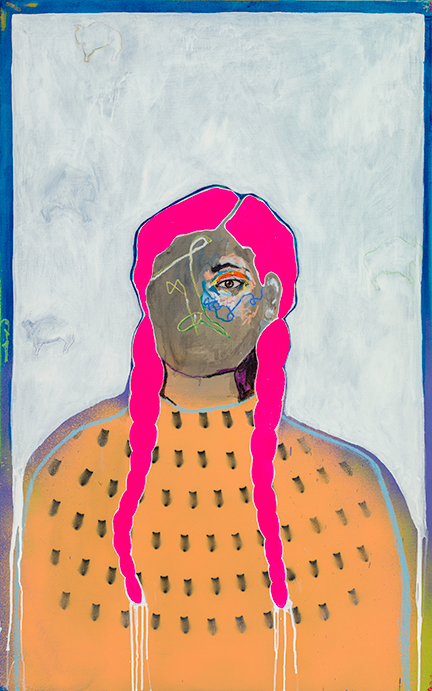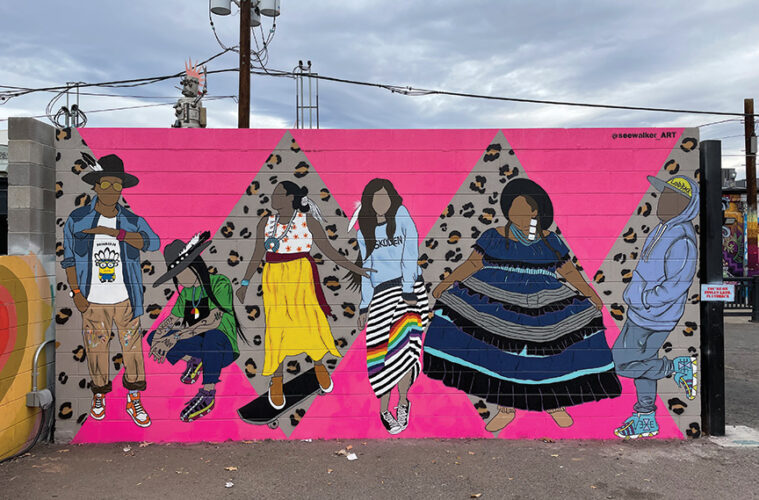BY SHALEEN DESTEFANO
We first fell in love with Danielle SeeWalker’s art at the second installment of Babe Walls this past summer. Babe Walls celebrates womxn and non-binary artists, providing blank walls around the metro area. Danielle’s mural, like most of her work, was rich with history and told a story that begged to be highlighted. To have the opportunity to learn more about her work and craft, has been a gift.
 We would love to begin by learning more about you, your connection to your heritage and how you became an artist.
We would love to begin by learning more about you, your connection to your heritage and how you became an artist.
Aŋpétu wašté, mitakuyapi. Danielle SeeWalker emaciyapi. Ma Húŋkpapȟa Lakȟóta, Íŋyaŋ Wosláta emátaŋhaŋ. Denver, Colorado el wathí. I wanted to greet all readers in my Lakȟótiyapi (Lakota language). What I said is: Good day to all my relations. My name is Danielle SeeWalker and I am a Húŋkpapȟa Lakȟóta citizen of the Standing Rock Sioux Nation. I currently live in Denver, Colorado. I was born and raised in North Dakota and have lived all over the United States but moved to Colorado in 2018. I have always been a creative spirit since forever. My dad was a very gifted, self-taught artist along with so many others in my family. Since I was a little girl, I had always used my creativity as an outlet for healing. I didn’t have the best upbringing but art was always a great crutch for me and a good medicine. Today, I have evolved quite a bit as an artist. I am a multidisciplinary artist and love to work in various media. I also got into mural work about a year and a half ago and that has been an absolute blast! I’m so very grateful for those opportunities to create public art. I also work out of my home studio and work on canvas, traditional bead-work and leather-work, jewelry and experimenting with mixing those together and using unconventional materials to paint on.
Your art is deeply inspired by your identity and heritage. Can you tell us the story you hope to tell through your work?
My work the past few years has been very much inspired by my identity as a biracial woman. I grew up very whitewashed in a very conservative environment, despite staying closely connected to my Native American family. However, the experiences I had as a young girl with being ridiculed and treated poorly at times made me feel very ashamed to claim my identity. I tried hard to avoid my Native American side for a very long time, but it was ultimately inevitable that I couldn’t ignore who I was. As a young adult, I began a journey of healing and acceptance and started working on a personal passion project called “The Red Road Project” with my best friend. This project was all about talking to other Native American people from around the country and allowing them to tell their own stories in their own words while we documented them. This project was an eye-opener for me because I realized that I wasn’t the only one that felt the way I did; I was able to finally interact and build relationships with people who understood my upbringing and shared very similar situations. My artwork today is sort of a visual diary of me telling stories of my heritage, my feelings, Native American history and contemporary topics. It is all centered on my journey of healing and reconciliation with identity and where I come from.
 Your body of work crosses many mediums. From murals to bead-work, how do you see your work evolving?
Your body of work crosses many mediums. From murals to bead-work, how do you see your work evolving?
I love constantly experimenting and dabbling in different mediums. I get sort of bored if I am stuck doing the same thing and using the same materials. Even if it’s a slight change, I like to be constantly doing something new. For instance, I have always used acrylic paint on canvas and I only started working with oil paints and aerosol paints in the past year. So, while I’m still painting and creating on canvas, using different types of paint has been really fun. I also love the idea of working in traditional arts like bead-work or leather-work but bringing to it, a contemporary twist. I’m currently into photo transfer on raw hide…so we’ll see what that brings!
Can you give us a glimpse into your process?
My process really depends on what I’m working on. With mural work, for example, I am much more calculated and planned-out in advance on what I will create. I actually have to use math and science when I plan out my mural (hear that kids – you will use math in real life one day!) I will usually take a photo of the wall or surface I plan to paint the mural on and then transfer to my iPad and draw out the sketch on that photo. Having accurate measurements and scale is very important. I’ve done more than a dozen murals and I’m still trying to get the hang of it all.
My studio work is a more free and open process; I don’t usually sketch out what I will create but rather just go with the flow based on what my mood is or what is on my mind. Color palettes are one of my biggest inspirations so whether I am working with beads or paint, I will almost always start with a color palette and then really just freestyle from there.
 You recently wrote your first book, Still Here: A Past to Present Insight of Native American People & Culture. Can you give us a quick synopsis?
You recently wrote your first book, Still Here: A Past to Present Insight of Native American People & Culture. Can you give us a quick synopsis?
The inspiration behind that book was from my experience working on The Red Road Project that I mentioned earlier. Through that project, I had been asked to give a lot of talks and lectures. I’m almost always asked the same questions. Things like “what is a reservation?” or “how many tribes still exist today?” etc. etc. I had also been asked if I would ever create teaching materials to be used in classrooms. One day, I was approached by a publication company to write a short book and I thought this was the perfect opportunity to put together an easy-to-read book that anyone from teens to adults could pick up and read to learn the foundation of Native American people, culture and brief history. It is a great starter book for someone that knows little to nothing about American Indian people or culture.
You are a mother, an artist and an activist. What can you tell us about your passion project “The Red Road Project?”
The Red Road Project began in 2013 as a personal passion project for me to work on with my best friend. She lives in Europe and so we wanted a reason to be able to share in our creativity but also see each other consistently. We also were really frustrated that the only stories that were ever told about Native American people and culture were the stereotypical and often very negative perspectives. I wanted people to know more about how amazing and beautiful my people were and the brilliant work being done in Indian Country that never gets highlighted. So we set out to tell those stories and redirect the narrative. It was also important to me that a Native American was leading this because it’s almost always a non-Native person telling our stories for us. We have traveled all over Indian Country meeting and interviewing Indigenous people living on reservations, urban areas and everywhere in between. These people are doing amazing things like advocating for our water resources, our four-legged, winged and water relatives, acting on language revival, taking legislative action, and so much more. For more info, you can visit our website: www.redroadproject.com
Colorado is brimming with artists and creative thinkers. Who are some of your favorite local artists?
Oh my goodness, I think I discover a new one every week! I am so, so, so inspired by the womxn and non-binary artists that I have gotten the chance to work with and meet through Babe Walls. I am part of the Babe Walls board committee and the mission there is to highlight and provide opportunities to womxn and non-binary artists when it comes to street art and more. Folx like Romelle, Alexandrea Pangburn, Koko Bayer, Grow Love, Gina Ilczyszyn, Kaitlin Ziesmer and Adrienne Norris are just a few of the badass artists I’ve been so fortunate to admire, then meet and now work with! There is nothing more inspirational than surrounding myself with powerhouse womxn who are big changemakers and that is exactly who they all are.
What can we expect from you in the future?
I am still actively working on murals and have several already lined up for 2022. I’m also humbled and pumped to be having my first solo shows locally. I will be at the Littleton Museum in the summer and then another show in the fall/winter at Alto Gallery in Denver. I am also still actively doing field work for The Red Road Project and focusing on the Indian Relocation Act that Denver was part of in the 1950-60’s. I want to uncover and document this local history and bring it to our community through an exhibition in 2023. Aside from artistic endeavors, I am the Co-Chair of the Denver American Indian Commission through the city & county of Denver and that work is very important to me. Much of my time is spent advocating and doing work for the Native American community here in Denver.
Danielle, thank you so much for giving us a glimpse into your past, present and future. If you’d like to learn more about Danielle SeeWalker and her projects, visit seewalker.com.

